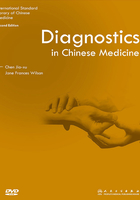
Section 4 Main Points for Analysing the Tongue Manifestations
1. Inspecting the Spirit and the Stomach Qi of the Tongue
(1) The manifestation of the tongue spirit
This mainly reflects the aspects of tongue colour and tongue body. The main point of pattern differentiation is the degree of redness and brightness of the tongue colour.
(2) Exuberance or debilitation of the stomach qi depends on whether the tongue coating is rooted or not.
A. A rooted coating is a sign of healthy stomach qi.
B. A rootless coating is a sign of loss of stomach qi.
In short, the tongue manifestation with spirit and stomach qi indicates a mild condition of disease, sufficientzheng qi or a severe condition of disease, but where the prognosis is good. The tongue manifestation without spirit and stomach qi indicates deficiency of thezheng qi, a severe condition of disease or a bad prognosis.
2. General Analysis of the Tongue Body and Tongue Coating
(1) Necessity
Disease is a reflection of the struggle betweenzheng (healthy) qi and pathogenic qi; the tongue coating and tongue body reflect the pathological changes from different angles.
The tongue body reflects the conditions ofzang-fu organs, qi, blood and body fluids.
The tongue coating is related to the nature of pathogen and pattern of disease.
(2) Principles
A. The changes of the tongue coating are in accordance with those of the tongue body, which indicate the same pathological processes. Diagnostically both of these combined together are most significant. For example:
• A red tongue body with yellow dry coating indicates an extreme heat pattern.
• A pale and tender tongue with white moist coating indicates a deficient cold pattern.
• A red, crimson and cracked tongue with scorched yellow and dry coating indicates extreme heat damaging fluid.
• A blue-purple tongue with white and greasy coating may indicates blood stasis and blockage of qi, phlegm-dampness obstructing in the interior.
B. The changes of the tongue coating may not be in accordance with those of the tongue body. Therefore this should be analysed according to the aetiological factors, pathogenesis and the relationships between them, and then cross-checking and making an integrated judgement. For example:
• A pale tongue with yellow and greasy coating suggests a deficient cold body invaded by damp-heat.
• A red, crimson tongue with white, slippery and greasy coating suggests an external heat pathogen or heat in theying level and dampness in the qi level; or hyperactivity of fire due to yin deficiency; invasion of a cold-damp pathogen or internal food retention.
• A pale tongue with yellow, greasy coating: The pale tongue body usually indicates deficient cold, but a yellow and greasy coating is the sign of damp-heat pathogen. This becomes obvious because the tongue body mainly reflects thezheng qi and the tongue coating mostly suggests the type of pathogen.
• A red, crimson tongue body with white, slippery and greasy coating: The red, crimson tongue refers to interior extreme heat, but the white, slippery and greasy coating is often seen in cold-damp accumulation. The tongue coating and tongue body reflect two opposite patterns: a cold pattern and a heat pattern. This may be caused by exterior pathogenic heat, heat into theying level, leading to redness of the tongue body, and dampness in the qi level, which causes a white, slippery and greasy tongue coating.
Therefore, when the manifestations of the tongue body are not in accordance with those of the tongue coating, it often indicates an occurrence of two or more pathogenic processes in the body. In clinic, if the manifestations of the disease are complex, observation of the tongue will be extremely valuable in conjunction with other signs. Generally one should pay particular attention to distinguish between the root (bĕn) and branch (biāo) in analysing a pattern.
3. Dynamic Changes of the Tongue Manifestation
When the tongue manifestation changes follow the pathogenic condition, it is a reflection of the changes of the pathogenic condition.
The tongue manifestation changes that follow the treatment are a reference for the success or failure of treatment, and medication.
In grasping the changes of the tongue manifestation, it is possible to recognise the essence of pathogenic changes sufficiently to assist in diagnosing and treating.
For example, in an exterior disease, the tongue coating changes from thin to thick, this indicates the pathogen is moving from the exterior into the interior; the tongue coating changes from white to yellow, which indicates the pathogen is transforming into heat; when the tongue colour changes into red with dry coating, this indicates a rampant heat toxin, blazing of both qi andying; a red tongue body with peeled coating indicates heat entering theying and blood levels and deficiency of both qi and yin.
In disease due to internal damage, such as with the tongue manifestation of windstrike, the tongue body changes from normal into red, dark-red, crimson, or dark purple with a yellow and greasy, scorched or black coating, or with distended sublingual veins, which indicates wind-phlegm transforming into heat, and/or obstruction of static blood. On the other hand, changes in the opposite direction, indicate a mild condition of disease and a good prognosis.